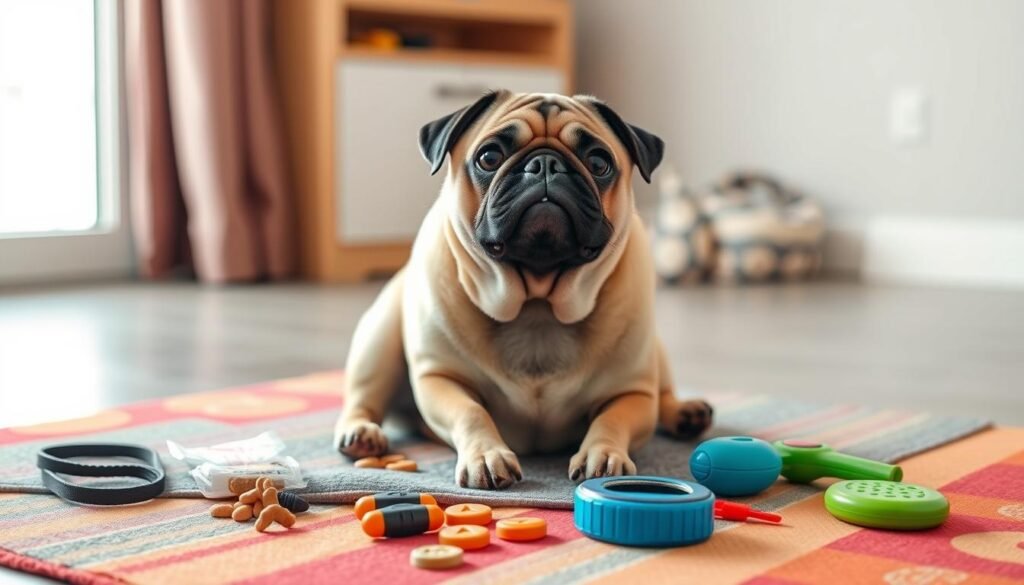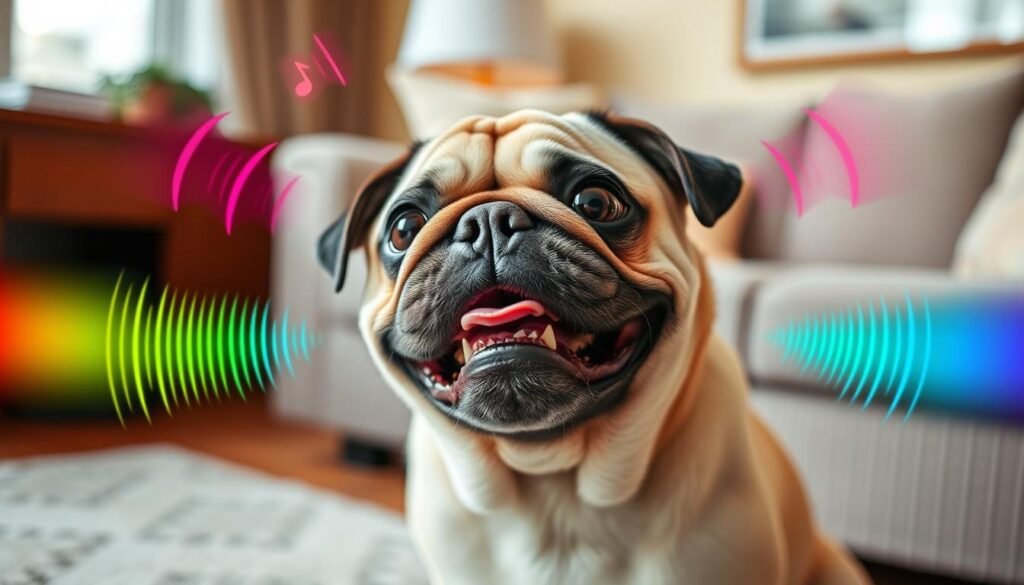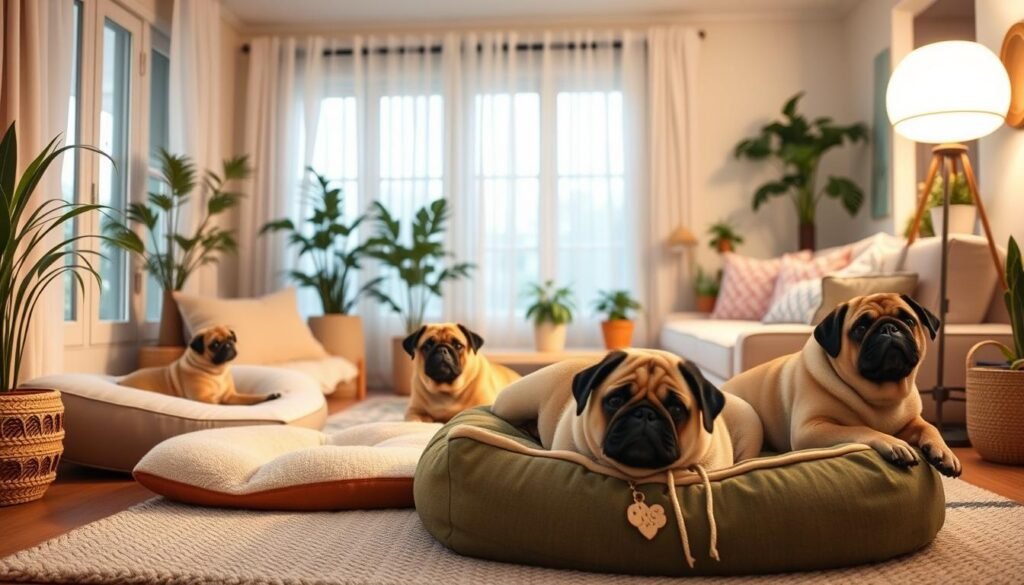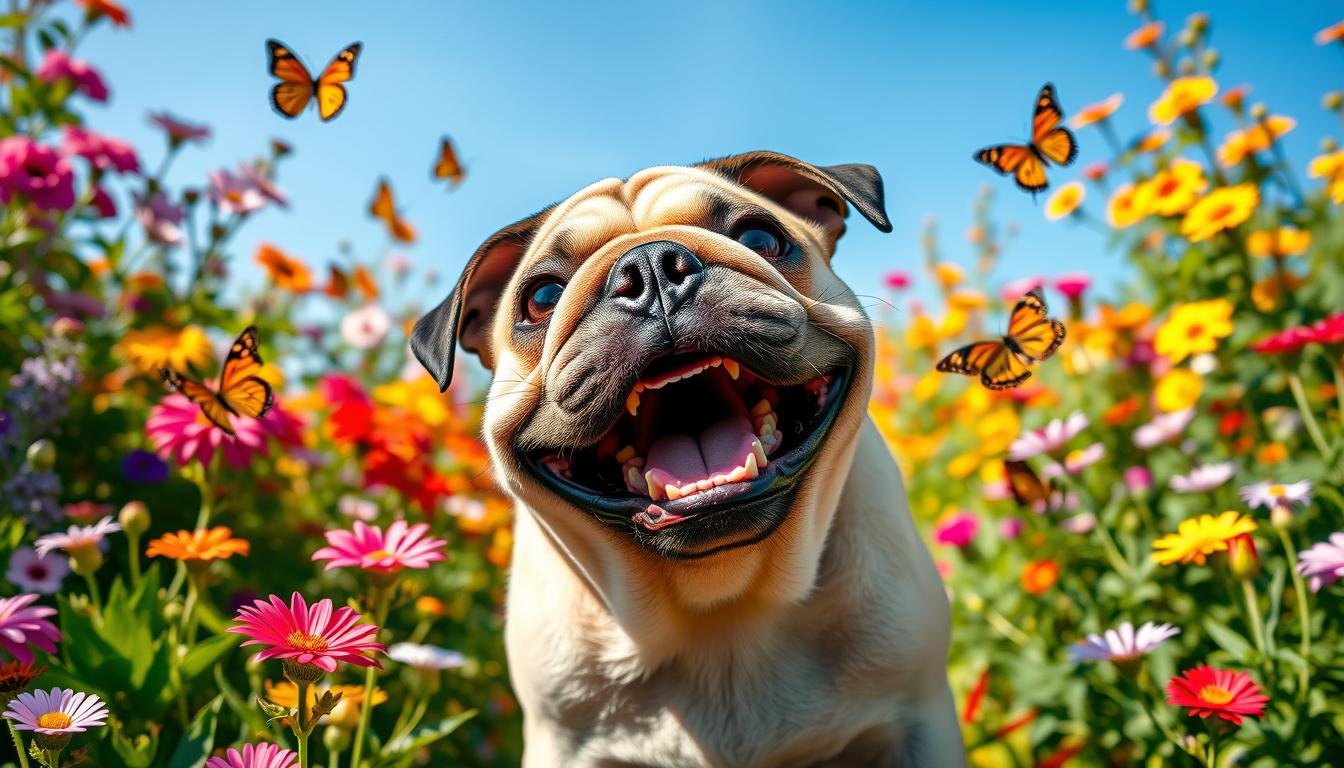How to avoid excessive barking in Pugs
Pugs are loved for their charming personalities. But, their barking can sometimes be a problem. This is especially true when they bark at strangers or other dogs. A study showed that 75% of Pugs bark a lot when they see other dogs.
Don’t worry, there are ways to make your Pug bark less. We’ll look at different methods to help your Pug be quieter and more well-behaved.
Your Pug might bark because they want attention, are bored, or react to things around them. We’ve got tips for you. By figuring out why your Pug barks and using positive training, you can teach them to communicate better.
Let’s explore how to make your home quieter and happier for both you and your Pug.
Identifying the Causes of Excessive Barking in Pugs

As a Pug owner, it’s important to know why your pet barks so much. Pugs are loving and playful, but their barking can be annoying. Let’s look at two main reasons for this: attention-seeking behavior and boredom or lack of mental stimulation.
Attention-Seeking Behavior
Pugs love to bark to get your attention. They might bark to play, be petted, or just for more love. If they don’t get enough time with you, they might bark more. Knowing this can help you stop their pug barking due to boredom and attention-seeking behavior in pugs.
Boredom and Lack of Mental Stimulation
Pugs are smart dogs that need to stay active and mentally sharp. Without enough fun activities, they might bark a lot. This pug barking due to boredom shows they need more pug behavior training and mental challenges.
By figuring out why your Pug barks too much, you can make a plan to help. You can give them the attention, exercise, and training they need to be a good friend.
“Understanding the triggers behind your Pug’s barking is the key to finding effective solutions and maintaining a harmonious relationship.”
Understanding the Pug’s Barking Sounds

Pugs are known for their unique and sometimes loud barking. But did you know their barks can tell you a lot about how they’re feeling? From the quick “yappy machine gun” bark to the funny scream and squealy whimper, knowing the different pug barking sounds and pug vocalizations helps you understand their pug barking patterns.
Excited Barking: When your pug is excited or eager, you might hear a high-pitched, rapid series of barks. This shows their excitement, like when they’re looking forward to playtime or a walk.
Alert Barking: If your pug barks intensely and continuously, it might mean they sense something unusual or feel threatened. This pug barking is their way of warning you of potential danger.
Relaxed Grunting: Softer, more content grunts when your pug is resting or being petted show they’re calm and comfortable.
“Behaviorists recommend an hour-a-day enforced chew time for dogs to help reduce excessive barking, with an emphasis on providing items to chew on for calming effects.”
Knowing these different pug barking sounds and pug vocalizations gives you insights into your pug’s needs and emotional state. By understanding the context and reasons behind their pug barking patterns, you can address any issues and make sure your pug is happy and healthy.
How to Avoid Excessive Barking in Pugs

Positive Reinforcement Training
Positive reinforcement training is a great way to stop Pugs from barking too much. When your Pug stays calm and quiet, reward them. Give them praise, treats, or affection for good behavior.
Providing Adequate Exercise and Enrichment
Make sure your Pug gets enough exercise and mental play. This helps them use up their energy and prevents frustration. Take them for walks, play with them, and use interactive toys.
Also, give them activities like puzzle feeders or training sessions. This keeps their minds busy and happy.
By using positive training and giving them lots of exercise and fun activities, you can make your Pug’s life better. This will help reduce their barking and make your bond stronger.
“Consistent, positive reinforcement training is key to addressing excessive barking in Pugs. It’s important to reward calm behavior and provide adequate physical and mental stimulation to prevent boredom and frustration.”
Managing Environmental Triggers

Your Pug’s barking can be affected by their surroundings. It’s important to make a calm space for them. This helps manage triggers that might cause too much barking.
Creating a Calm and Relaxing Environment
First, create a cozy spot for your Pug to relax. Use a comfy bed or crate. Add calming things like:
- Soothing scents, like lavender or chamomile, to help reduce anxiety
- Soft, ambient music or white noise to mask external sounds
- Toys and interactive puzzles to keep your Pug mentally stimulated
This calm environment makes your Pug feel safe. It also stops them from barking too much. Keep them away from loud noises and sudden movements for a quieter home.
“The key to managing environmental triggers for Pug barking is to create a sanctuary-like space where your furry friend can feel safe and secure.”
Creating a peaceful environment is key. It makes your home a happier place for you and your Pug.
Using Bark Control Tools Responsibly
Managing your Pug’s excessive barking might lead you to consider bark control tools. But, it’s key to use these tools carefully and with caution. Shock collars should be avoided as they can hurt and cause more problems. Vibrating collars might be an option, but they must be used with care because of Pugs’ sensitive trachea.
If you choose to use a bark control tool, always watch your Pug closely. Never leave the device on your dog alone. This way, you can make sure your Pug is safe and comfortable. Talk to a dog trainer or vet to learn how to use these tools right and avoid hurting your Pug.
- Avoid using shock collars, as they can be harmful and lead to further behavioral problems.
- If using a vibrating collar, be cautious due to Pugs’ delicate trachea and monitor your dog closely.
- Never leave a bark control device on your Pug unsupervised.
- Consult a dog trainer or veterinarian for guidance on the responsible use of bark control tools.
The main goal is to fix the reasons behind your Pug’s barking, like boredom or needing more exercise. By tackling these issues and using bark control tools wisely, you can help your Pug become a well-behaved and happy friend.
“Responsible use of bark control tools is crucial for the well-being of your Pug. Avoid harsh methods and work closely with a professional to address the root causes of the behavior.”
Addressing Health-Related Barking in Pugs
Excessive barking in Pugs can sometimes be a sign of health issues. This includes Canine Cognitive Dysfunction or deafness. If you think your Pug’s barking is due to health problems, see your vet. They can check your Pug and help manage any health issues causing the barking.
Pugs with cognitive decline, often seen in older dogs, may bark more. This could be due to feeling lost or anxious. Your vet can check your Pug’s brain function and suggest ways to help with the barking.
Pugs with hearing loss may bark more to communicate or react to sounds they can’t hear. Your vet can test your Pug’s hearing. They might suggest special devices or training to help with the barking.

